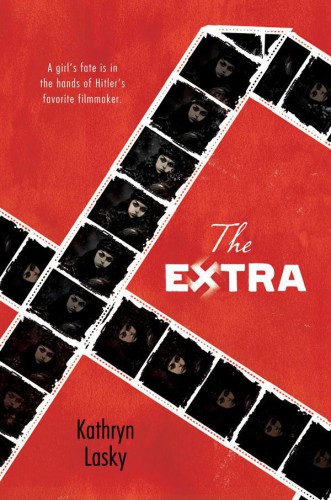
The Extra
فرمت کتاب
ebook
تاریخ انتشار
2013
Lexile Score
660
Reading Level
3
ATOS
4.6
Interest Level
4-8(MG)
نویسنده
Kathryn Laskyناشر
Candlewick Pressشابک
9780763667122
کتاب های مرتبط
- اطلاعات
- نقد و بررسی
- دیدگاه کاربران
نقد و بررسی

September 16, 2013
Lasky (the Guardians of Ga’Hoole series) delivers a well-researched and uncompromising standalone novel focusing on the Nazi genocide of the Roma and Sinti peoples. Lilo—a Sinti girl of 15 at the beginning of the book—is taken by the Nazis when they start rounding up the Romani of Austria. Lilo’s losses mount quickly as she’s separated from her father and many of her friends; only the opportunity to be an extra in the cast of a film by Nazi propagandist Leni Riefenstahl might save her. Along with a musically gifted boy named Django, Lilo learns the ins and outs of the concentration camps and witnesses the genocide as it affects her loved ones. Lasky’s novel is thorough in its attention to detail, mixing facts like Riefenstahl’s awful behavior toward her charges with the horrific lives of the fictional characters. Only a slightly rushed ending throws off the pace, but even then, between the constant, appalling brutality of the camps and Lilo’s growth over the years, Lasky draws remarkable depth, realism, and even charm out of a bleak story. Ages 12–up.

December 1, 2013
Gr 8 Up-In 1940 Vienna, 15-year-old Lilo lives with her mother and father under the watchful eyes of the Nazis, who have recently fingerprinted and identified the family as a part of the "Gypsy plague." Soon after, they are arrested and taken to jail to await deportation to an internment camp. When they are separated, Lilo and her mother are transferred to another camp where they are selected to be extras in Leni Riefenstahl's latest film. Treated as slaves, they are all at the mercy of the mercurial director, who quickly dispatches those who displease her. When her mother disappears, The teen escapes to Salzburg where she is hidden from the Gestapo but then recaptured. Facing extermination, she makes the courageous decision to escape once again, leading to her eventual rescue by Allied forces. Inspired by actual events, Lasky's intense novel exposes readers to the atrocities endured by Gypsies during World War II, specifically those who worked on the film Tiefland. Told from a third-person point of view, the story never really allows readers to feel what Lilo feels yet it manages to convey the horrors she witnesses with frightening clarity. The narrative moves briskly as characters come and go in Lilo's life, which is beneficial since many of the supporting figures are flat and indistinguishable from one another. With its abrupt ending, however, the story seems unfinished and may leave readers wondering what Lilo's future holds.-Audrey Sumser, Cuyahoga County Public Library, Mayfield, OH
Copyright 2013 School Library Journal, LLC Used with permission.

September 1, 2013
The rarely told story of the Nazi genocide of the Romani people unfolds through the eyes of a heavily fictionalized "film slave," a Romani girl forced into service as an extra in a Leni Riefenstahl film. Lilo is 15 when the Nazis cart her family off to a concentration camp. She'd assumed they were safe--settled, urban, skilled Sinti, unlike Roma who traveled in caravans and were easier targets of bigotry. But there's no safety in Buchenwald or Maxglan, where her mother is the subject of sadistic procedures and her father vanishes in the night. In a stroke of luck, she's taken to be a forced extra, a film slave in the backdrop of Leni Riefenstahl's film Tiefland. Along with the other Romani imprisoned by Riefenstahl, Lilo fights to stay alive in circumstances less extreme than the camps but still horrific. Filmmaking details provide a unique flavor in a tragic story that's otherwise all too familiar. Amid death and torment, Lilo encounters unexpectedly frequent sparks of human decency. Conveyed in at-times overly expository prose, Lilo's story is fiction laid upon the life of actual Romani Holocaust survivor Anna Blach. Context is provided by a deeply problematic author's note, which dedicates more than four pages to Riefenstahl but only three sentences to the modern Romani, mentioning neither the modern reality of anti-Romani bigotry nor the simple fact that "Gypsy" (used through the note as synonymous with "Romani") is now considered pejorative and should be avoided. In the end, the touching story of survival carries readers over the occasional infelicities. (Historical fiction. 12-16)
COPYRIGHT(2013) Kirkus Reviews, ALL RIGHTS RESERVED.

October 15, 2013
Grades 8-12 The year is 1940. Lilo, 15, and her family are Gypsies (Romani) who have been rounded up by the Nazis and sent to the Maxglan internment camp. It is there that Leni Riefenstahl, Hitler's favorite film director, selects Lilo and her mother to serve as extras in her new movie, Tiefland. As shooting of the film begins, Riefenstahl quickly emerges as a beautiful but feral and very, very dangerous woman. As for the extras, they're little more than slaves who are living not in a cinematic dreamworld but, instead, in a waking nightmare. Aside from her mother, the only bright spot in Lilo's life is the boy Django, a brilliant survivor and indispensable information-gatherer. But even he can't know what their fate will be when the filming concludes. Could it be freedom? Lasky has written a harrowing and deeply moving novel that focuses attention on a seldom-told story of the Nazis' attempt to exterminate the Romani people. Thoroughly researched and insightful, the book is ideal for classroom use and discussion.(Reprinted with permission of Booklist, copyright 2013, American Library Association.)

























دیدگاه کاربران